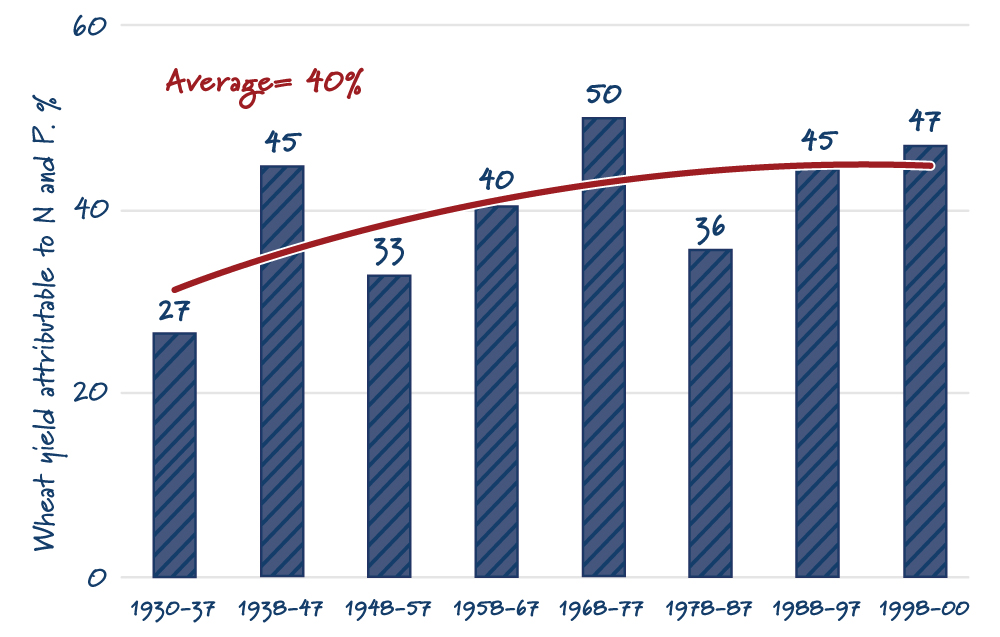Posted on April 11, 2024 by Jasmine Yu and Chloe Binford
The U.S. agricultural productivity boom in the mid-20th century resulted from innovative fertilizer technologies. Novel technologies like synthetic fertilizers helped revolutionize fuel, food, fiber and feed production. Synthetic fertilizers are also directly linked to U.S. economic growth and prosperity and reduced reliance on other countries. Today, the U.S. continues to lead the world in finding new ways to enhance agricultural productivity and efficiency while producing clean and reliable ammonia for fertilizer production and reducing agricultural sector emissions.
Fertilizer provides essential plant nutrients to maximize productivity
Agricultural resources like crops and other feedstocks grow and produce food, fuel, fiber and feed through photosynthesis, which uses water, sunlight and CO2 from the atmosphere. Nutrients like nitrogen, phosphorus and potassium are needed to ensure the health and productivity of these resources to optimize growth and yields, similar to how people need a diverse, nutritious diet to stay healthy and grow. These essential nutrients can be found naturally in agricultural fields in varying amounts, depending on the location. However, for certain crops, fertilizers can optimize these conditions. For example, long-term research in Iowa showed that corn yields averaged 60 bushels per acre without fertilizer, and corn fertilized with nitrogen easily yields 200 bushels per acre. Fertilizers for crops are like food for humans, supplying essential nutrients to plants. Fertilizer can be stored, transported and applied in various forms (i.e., liquid, solid). The type of fertilizer used depends on the plant being grown and environmental conditions, similar to how the food intake for a marathon runner will differ from that of a weightlifter.
Figure 1. Fertilizers for Crops Is Like Food for Humans

The Haber-Bosch process, invented in 1913, is a crucial scientific discovery, and the technological innovations that came from it revolutionized the world. The Haber-Bosch process is the main industrial method of producing ammonia. The most prominent innovation from the process is the creation of synthetic nitrogen fertilizer. This spurred the rapid growth in crop productivity beginning in the mid-1900s and supported the growing global population. Long-term field studies across the U.S. dating back before the development and use of synthetic fertilizers have shown the positive impact of fertilizer use on crop yield. A review of crop production across 362 crop growing seasons showed that synthetic fertilizers are responsible for at least 30-50 percent of crop yields. Location-specific research done on the Magruder Plots in Oklahoma, the oldest continuous soil fertility research plots in the Great Plains region of the U.S., found that, on average, over 71 years, nitrogen and phosphorus fertilization was responsible for 40% of wheat yield in America (Figure 2).
Figure 2. Wheat yield attributable to nitrogen and phosphorus fertilizer in the Oklahoma State University Magruder plots (1930-2000)

Source: Better Crops
U.S. leadership in fertilizer innovation is needed now
Food security is national security. The U.S. food system is heavily reliant on fertilizer production from adversaries like Russia and China, which could limit fertilizer supply to the U.S. and reduce America’s ability to provide affordable food and fuel domestically and globally. For example, the Russia-Ukraine conflict resulted in fertilizer trade restrictions across the globe, driving up fertilizer prices and increasing grain prices. Therefore, U.S. leadership in fertilizer production is essential to reduce American dependence on international fertilizer production and to ensure American farmers have access to affordable and reliable fertilizer to fuel and feed the nation.
As the U.S. leads in fertilizer innovation through initiatives like USDA’s Fertilizer Product Expansion Program (FPEP) that aims to expand the manufacturing and processing of fertilizer in the U.S., American ingenuity is also beginning to address the emissions impact of fertilizers, as the production and use of fertilizer accounts for approximately 5% of global emissions. Recent studies on the full life-cycle of fertilizers found that emissions could be reduced by 80% by 2050 without impacting productivity. Fertilizer production accounts for around one-third of synthetic fertilizer emissions, while the remaining two-thirds derive from fertilizer use. As a result, if we want to reduce emissions, we must find a way to both decarbonize fertilizer production and develop technologies and practices to reduce emissions from nitrogen fertilizer. Technological innovation will be key to ensuring that we do so in a manner that does not increase costs or decrease yields.
Clean ammonia can reduce fertilizer production emissions
Ammonia production is a major global industry that accounts for 2% of total energy consumption and 1.3% of CO2 emissions. It is produced by combining nitrogen from the air and hydrogen through the Haber-Bosch process. Approximately 70 percent of ammonia produced is used for agricultural fertilizers. The U.S. has cleaner ammonia production compared to its international counterparts, with American ammonia being approximately 24% less carbon intensive than the global average. The U.S. is also twice as efficient at producing ammonia as China, the largest producer and consumer of chemicals.
As the global population increases and becomes more affluent, demand for fertilizer will increase, resulting in the need for more ammonia. The U.S. is primed to lead in clean ammonia production as demand rises. To maintain America’s competitive advantage, the U.S. needs to support the research and development (R&D) of innovations that reduce emissions during ammonia production, such as electrolysis, methane pyrolysis and carbon capture and storage. Supporting R&D efforts can make American ammonia more affordable, reliable and cleaner and encourage the deployment and commercialization of viable technologies to reach net-zero goals by 2050.
Innovations to reduce agricultural nitrous oxide emissions
Nitrous oxide, like carbon dioxide, is a gas in the atmosphere that accounts for around 6 percent of U.S. greenhouse gas emissions. Nitrous oxide is also 300 times more effective at trapping heat than carbon dioxide. In agriculture, more than 70 percent of nitrous oxide comes from agricultural soil management. Nitrous oxide emissions result from natural microbial processes in the soil that convert nitrogen, an important nutrient for plants, to nitrous oxide. Multiple factors such as the amount of nitrogen in the soil, type and amount of fertilizer used, crop type and soil conditions (including type, pH, temperature and moisture level) can impact the amount of nitrous oxide emitted. As such, innovations to reduce nitrous oxide will differ based on location, crop type and nutrient management practices. Implementation of the 4R principles (right source, right rate, right time and right place) through the 4R Nutrient Stewardship Framework, developed by the fertilizer industry worldwide, is one way the agriculture sector is working to reduce emissions. Examples of innovations include enhanced efficiency fertilizers that control fertilizer release or prevent the biological process of nitrous oxide emissions, breeding and engineering crops with greater nitrogen use efficiencies and biostimulants (i.e., microbial fertilizers) that support plant growth and nutrient uptake.
U.S. agriculture is highly productive due to the historical adoption of innovations like enhanced seeds. Continued R&D that correlates reductions in nitrous oxide emissions with cutting-edge technologies could encourage more innovation deployment and more affordable implementation.
Policy Opportunities
Support for and utilization of policy levers can enhance fertilizer innovation in the U.S., further improving agricultural productivity and efficiency while reducing emissions from the agricultural sector.
Coordination between Relevant Federal Agencies — Enhance the coordination and collaboration among existing and future agriculture innovation research, such as between the USDA, DOE, NASA and NSF, to leverage resources across the federal government and streamline the innovation pipeline from research to deployment.
